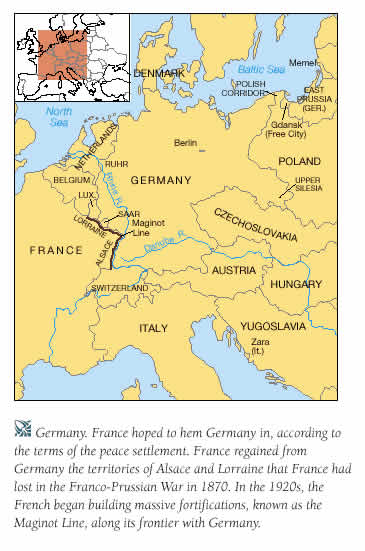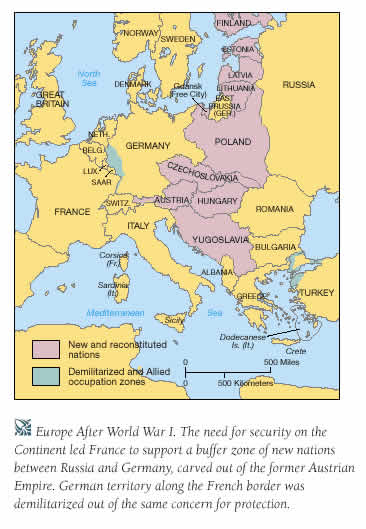readings for this week:
Paxton and Hessler, Chapters 8, 9
start Moeller, The Nazi State and German Society
HOPEFUL,
DIVIDED, AND DEMORALIZED DEMOCRACIES
I. The Paris Peace Conference
II. Parliamentary Democracy Spreads and Grows Up
Intermission: Democratic and Socialist Experiments in Interwar Europe
III. Symbols of "Normalcy": Currencies and Father Figures
IV. Problems in the Parliamentary Democracies: Great Britain, France, Italy,
and the Successor States
V. Democracy in Germany: The Weimar Republic
Shaping the Paris Peace Conference (1919): three competing visions
1. Traditional balance of power politics
a. revenge: weaken Germany
b. alliances (but England reluctant)
2. “Lenin” = revolutionary socialism
workers' uprisings against capitalism in the advanced capitalist countries
anti-imperialism (national liberation in European colonies)
3. “Wilson” = liberal idealism | “Fourteen
Points”
self-determination of peoples
free trade, freedom of the seas
collective security: League of Nations
Treaty of Versailles (1919)
1. loss of territory
--in west: Alsace-Lorraine, occupation of Rhineland
--in east: Poland (“Polish corridor,” Danzig)
2. disarmament: limits on size and weapons
3. reparations: Article 231 (“War Guilt” clause)
critique of the Treaty: John Maynard Keynes, The Economic Consequences of
the
Peace (1920)
map: Germany after the Treaty of Versailles:

Original can be found at:
http://wps.ablongman.com/wps/media/objects/262/268312/art/figures/KISH_27_633.gif
map: successor states in East-Central Europe after the Paris Peace Conference

Original can be found at:
http://wps.ablongman.com/wps/media/objects/262/268312/art/figures/KISH_26_601.gif
Democratic and Socialist Experiments in Interwar Europe
Q: what does democracy require, in addition to the vote and an constitution?
Q: what does a non-Communist (i.e. not Leninist) socialism look like?
1. "Red Vienna"
Austrian Social Democratic party | wins elections to run city of Vienna (but not the Austrian national government)
progressive social policies (public housing, health care)
a complete social democratic culture (workers' symphony orchestra, sports teams…)
Vienna as a Social Democratic island in a hostile sea (of rural, Catholic Austrian conservatism)
Red Vienna violently suppressed by the Austrian national government in 1934 as part of turn to authoritarianism in Austria
2. Interwar Sweden
Swedish Workers' Party (social democrats) win elections to control the national government
key concept: folkhemmet, or the nation as the "people's home"
key to political success: pragmatic alliances between workers, peasants, middle class, and large corporations
"The basis of the home is community and togetherness…In the good home, there is equality, consideration, cooperation, and helpfulness. Applied to the great people's and citizens' home [i.e., the nation], this would mean the breaking down of all the social and economic barriers that now separate citizens into the privileged and the neglected, into rulers and dependents, into the rich and the poor…the plunderers and the plundered."
--Per Albin Hansson
n.b. interwar Sweden also responds to the Great Depression more successfully than other European parliamentary democracies
map: authoritarian states in Europe by 1938/1940
Original can be found at:
http://wps.ablongman.com/wps/media/objects/262/268312/art/figures/KISH571.jpg
we are seeing “the
universal acceptance of democracy as the normal and natural form of government.”
James Bryce, Modern Democracies (1921)
Dilemmas of socialist parties in the 1920s
1. power-sharing and governing: compromise, or let coalition governments fail?
2. identity crisis: reform vs. revolution
3. relations with Communist parties (hostile)
and a question: what to do when the Great Depression hits? is this the beginning of the end of capitalism?
Parliamentary democracy faces the challenges of the interwar period
pattern 1: Italy--parliamentary democracy overthrown by fascism
pattern 2: Great Britain and France--great power malaise
pattern 3: successor states in East-Central Europe--turn to authoritarianism
the exceptions: Czechoslovakia and Finland.
The vulnerability of parliamentary democracy in Italy
1. politics: trouble with democratization (including weak, shifting coalition governments)
2. economic development: industrial class conflict, rural poverty
3. stress of WWI, chaotic demobilization
4. perception that Italy had been humiliated after the war
5. uprisings in postwar period (strikes, land seizures)
Great Britain and France in the
1920s: bastions of normalcy?
1. well-established political cultures
2. conservative parties in power for most of 1920s
3. strong world position: British empire, French army
Great Britain and France: undercurrents
1. rising socialist parties become main opposition: what will they do?
2. world position rapidly eroding
Q: Why did the successor
states turn to authoritarianism and fascism?
1. politics: constitutions not enough without infrastructure (civil society,
political culture)
2. economics: misery in countryside, depression in agriculture; autarchy in wake of Great Depression
3. nationalities: conflicts that can be exploited by authoritarian and fascist
demagogues; antisemitism used as a rallying device
a crucial point about nationalities in Eastern (or East-Central) Europe:
There is no way to draw neat borders around single-nationality states during the interwar period. The populations are too mixed.
(see the maps in Paxton and Hessler)
What is the eventual "solution?" Move people to fit borders. In practice, this meant extreme brutality: mass explusions, "ethnic cleansing," exterminations, refugees.
Germany’s Weimar
Republic (1919-1933): achievements
1. the most democratic constitution in Europe
2. supported by the original "Weimar coalition": moderate socialists (SPD), democrats, Catholics
3. pioneered the modern (post-WWII) welfare state
4. integrated the socialist working class (SPD)
5. survived severe early crises (1918-1923) and then stabilized (1924-1929)
6. produced a brilliant culture: debate about modernity (often referred to as "Weimar Culture")
Germany’s Weimar Republic: problems
1. Constitution:
a. proportional representation: weak coalition governments
b. presidential emergency powers to rule by decree
2. Treaty of Versailles (not the absolute amount of reparations;
instead: gave radical nationalists an issue)
3. Opposition of powerful elites
4. Catastrophic social experiences (1923 inflation,
Great Depression after 1929)
5. Political polarization (Nazis; Communists;
weak centrist parties)
two views of modern Germany to explain “why Nazism”:
1. a German special path (Sonderweg thesis): uneven modernization, weak civil society,
authoritarian political culture
2. intense modernization plus a series of catastrophes (loss of World War I,
hyperinflation, depression)
Weimar Republic (=Germany post-WWI)
“successor states” in east-central Europe:
Czechoslovakia (= Czechs + Slovaks)
Yugoslavia (“southern Slavs”)
Poland
Baltic states: Latvia, Lithuania, Estonia
Finland
reduced versions of Austria, Hungary, Bulgaria
constitutions
presidential system (U.S. model)
proportional representation (French model)
women’s suffrage
Socialist / Social Democratic / Labour (GB) parties
“return to normalcy” (Warren Harding)
German Mark / British pound sterling
gold standard
German hyperinflation of 1923 (German Mark)
Paul von Hindenburg
Weimar
German revolution of 1918
presidential emergency powers (Article 48)
proportional representation
coalition governments (unstable)
reparations (Versailles treaty)
German inflation of 1923
a “republic without republicans?”
Weimar culture